Update 2/11/19: Corrected the infotainment system screen size.
Elon Musk may lament that the affordable EV is a unicorn, but the 2019 Chevy Bolt is here to prove EVs can be affordable, appealing, and, yes, mundane enough to be your everyday vehicle.
Chevrolet, of course, has the benefit of mass production on their side. But even they have to make concessions. They’ve recently announced the discontinuation of the Chevrolet Volt hybrid (thus ending one of the most confusing product name conflations EVER). In order to make EVs profitable on a large scale, it became necessary to either go all in or be stuck with hybrids forever.
Based on how polished a vehicle the Bolt is, I think they’ve made the right choice.
Same as It Ever Was
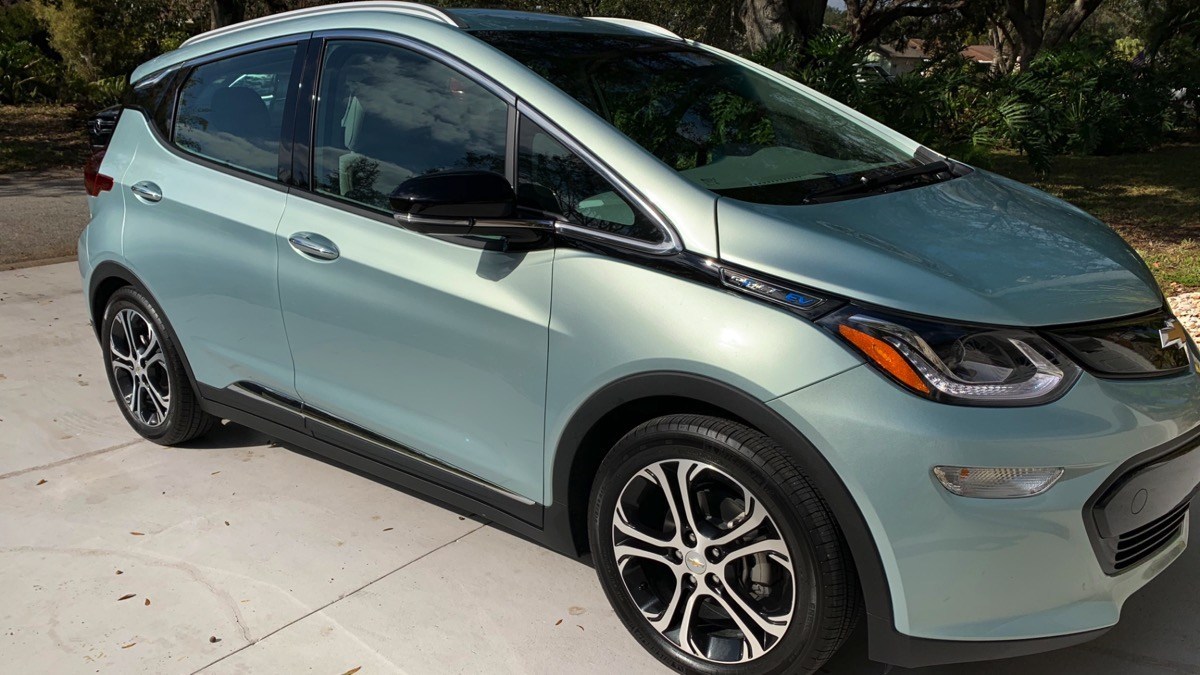
From the outside, the 2019 Bolt is virtually identical to the previous model years. Sure, there are new paint colors, this year’s Shock is for those of you who want your car to look like a neon-green jawbreaker, but the Bolt remains the same bite-sized hatchback.
It’s What’s Inside That Counts
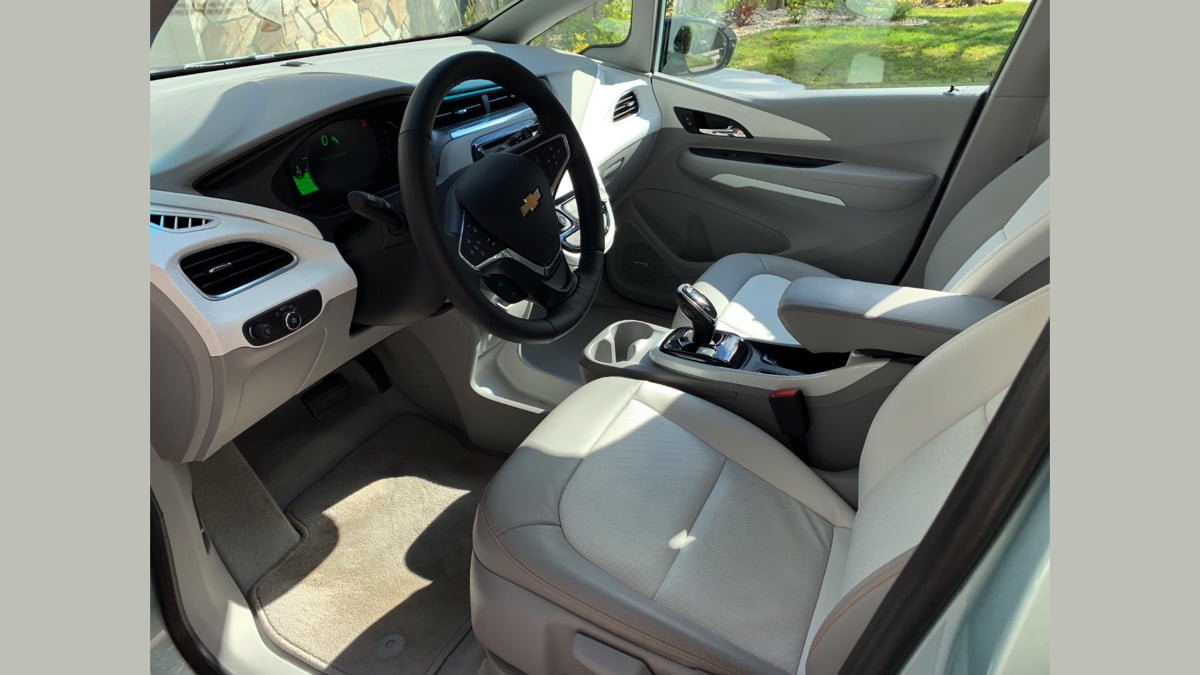
It’s a distinctive vehicle that feels much bigger on the inside than the outside. Chevrolet reclaimed the room that would usually be taken up by a full-sized engine, pushing the front seats and dash forward. There’s also no transmission hump (like the e-Golf’s vestigial hump), leaving you with a flat floor from front to back.

The arena seating in the second row gives your passengers a more SUV-type ride.
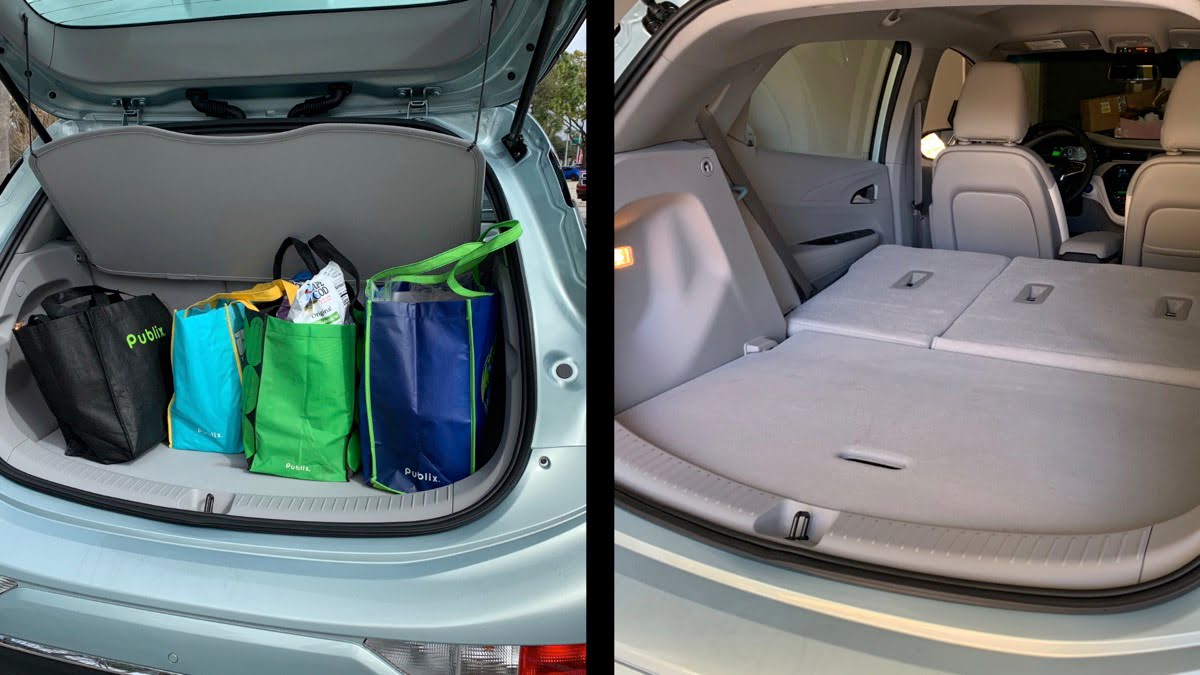
And there’s plenty of room in the back for cargo. Drop the second row of seats and you’ve got enough space for tons of gear.

The Premier trim and additional safety features of my loaded Bolt EV push the price over $40,000 (the base model is around $36k), but they make the Bolt a much more pleasurable vehicle to drive. The steering wheel is wrapped in pleasingly soft leather, and the Bose speakers pump out crystal-clear music (though the JBLs in Toyota’s Highlander still win for window-rattling bass). Heated seats (front and back!) make hopping in on cold winter mornings less of an ordeal.

While both trims can upgrade to the safety package that includes front pedestrian braking, collision warning, and a follow indicator, the more useful surround vision, rear parking assist, and cross traffic alert is only available with the Premier trim. Whenever I drive a vehicle with the added safety features, I always panic going back to my old ’05 Odyssey. The amount of extra confidence they impart can’t be discounted.
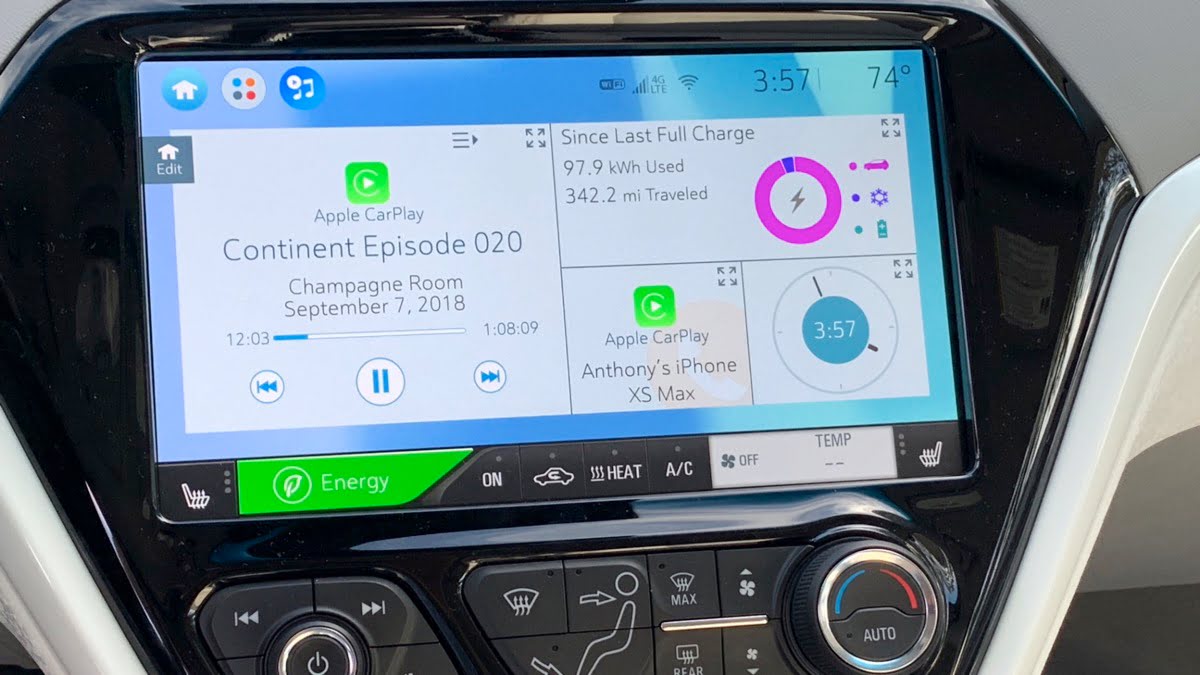
The 10.2-inch infotainment system is impressively large. I don’t even need an extra screen to see all of my Apple CarPlay apps. While the extra room is nice, it actually kept me from staying in the CarPlay interface all the time. The driver’s-side edge of the interface is blocked behind the steering wheel (or at least it was for me). Luckily, the customizable MyLink interface is more than functional and gave me access to additional information, like what systems were pulling the most power from the battery.
Shorty Got Low
Driving the Bolt never fails to bring a smile to my face. More than one of my passengers was startled into saying “This thing is on?” when I’d shift into reverse (which, admittedly, takes a more complex move than it should) and we’d start to roll back.
The Bolt is quiet. It’s so quiet you can hear a tween muttering to herself in the backseat. It’s so quiet that you’ll glare at all the noisy cars around you at stoplights.
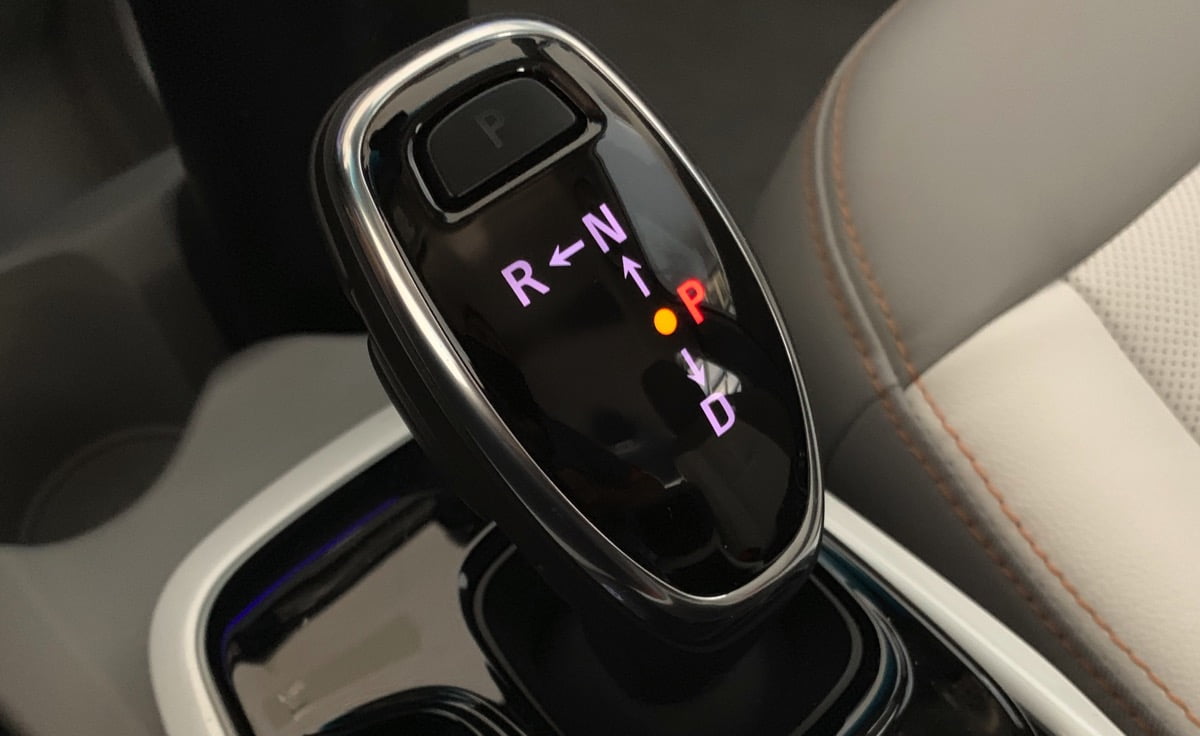
You have options when you’re tooling around town. The easiest is to just leave the Bolt in Drive. It will reclaim power from the battery when you brake. You’ll also brake more often since the vehicle will emulate an ICE vehicle: slowing down gradually when you take your foot off the accelerator pedal and creeping forward when stopped.
More interesting, however, and my preferred mode, is when you bump the shifter back a second time to engage Low. In Low, the Bolt aggressively slows itself down whenever you take your foot off the accelerator, reclaiming even more energy than you would if braking. When you come to a complete stop, you stay stopped without having to touch the brake pedal. It’s one-pedal-driving at its finest, and driving in this mode around town allowed me to reclaim roughly half the energy I used on every trip.
You can select Sport mode in both modes. It gives you a little more pep but comes at the cost of efficiency. Not that you need an extra boost. As with any EV, all the power and torque you need are there as soon as you hit the accelerator. There are no gears to grind through, letting you rabbit away from every stoplight. (But don’t do that, it kills your efficiency, m’kay?)
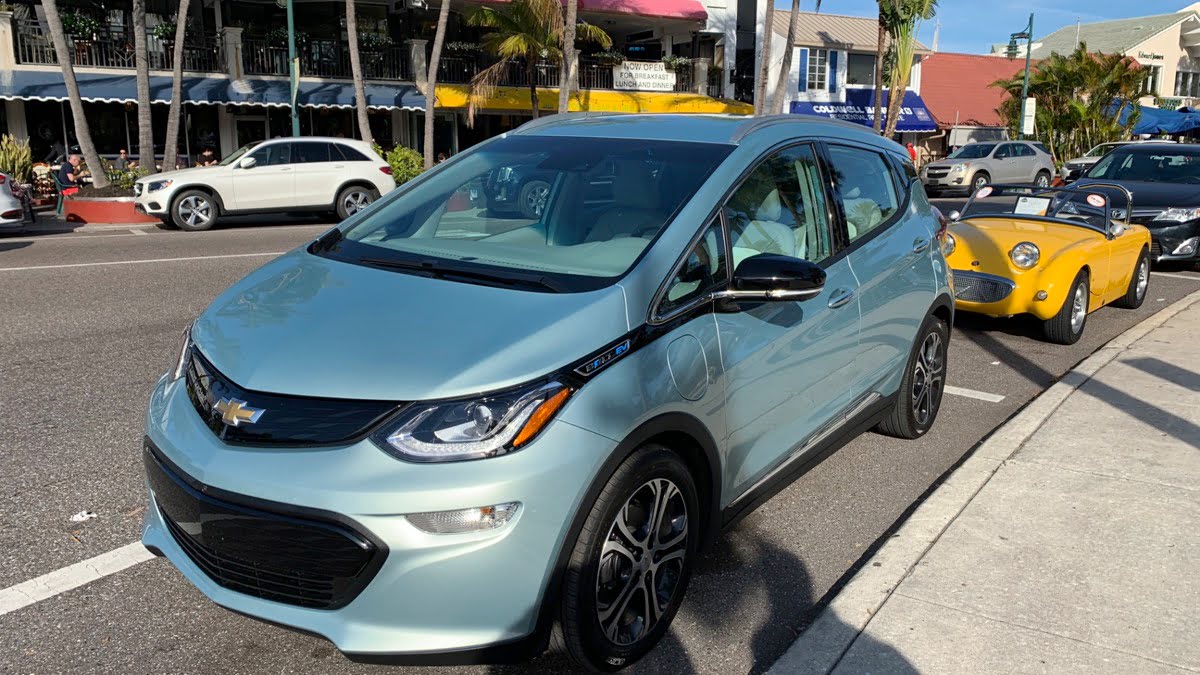
Maneuvering the Bolt is a breeze, and parking is so ridiculously easy (especially with the standard backup camera) that I started looking for more challenging places to squeeze the Bolt into just to make it interesting. More than once, I’d get out of the Bolt only to find that I was only taking up half the space of a normal vehicle.
What? Me Worry?
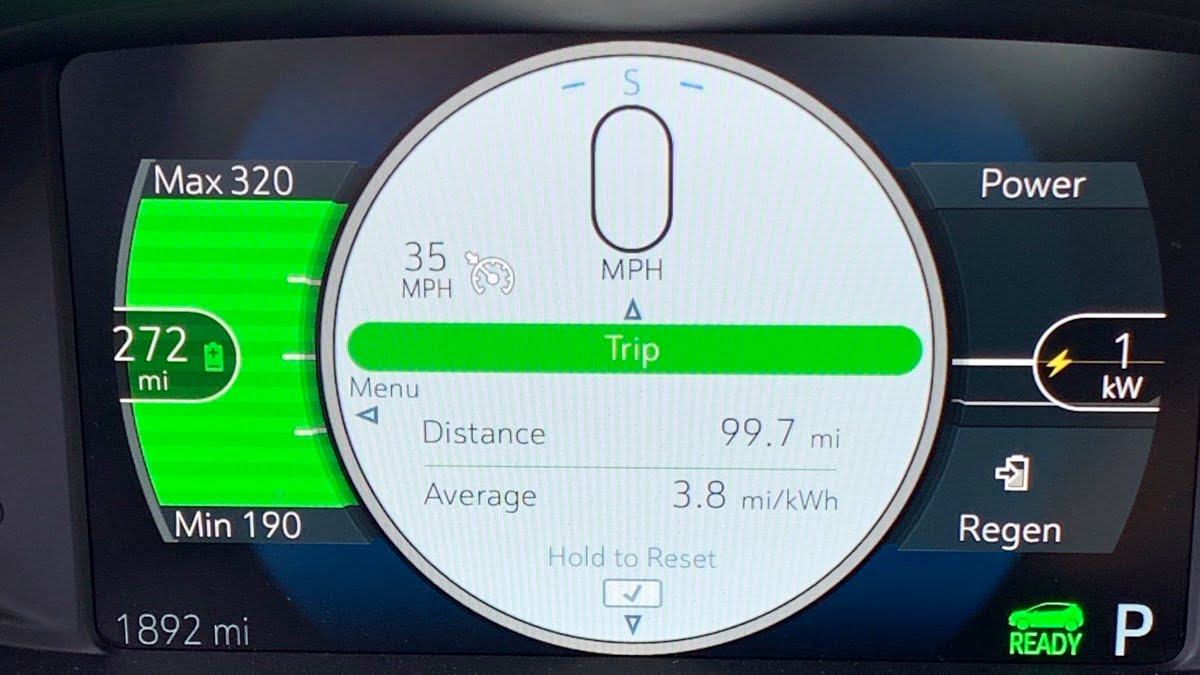
I’ve mentioned “efficiency” about a million times when discussing the Bolt. But range anxiety in a vehicle that gets over 230 miles on a full charge simply doesn’t exist. After the first few trips around town, where I doggedly hypermiled and used every hack I’ve developed to drive economically, I stopped watching my efficiency scores and stopped worrying.

One of the reasons is that it’s so easy to keep the battery topped off. There are chargers available all over town, so it was a simple thing to plug in while I shopped. The battery settings will helpfully let you set the maximum charge percentage as well so that you’re not constantly filling the battery to the max (which counterintuitively reduces battery life over time). Whenever I hit the road, I consistently had over 150 miles of charge, often returning home with only half the distance I’d traveled deducted from my overall range (due to reclaimed energy).
On the highway, you’ll see the range drop faster, and you’ll want to make sure there’s a charger waiting for you at your destination, but we’re still talking about hundreds of miles of range. Even the most dogged commuter should be able to get a full round trip out of that. What’s nice is that, when you’re stuck in traffic, instead of chewing through whatever is in your gas tank, your power consumption drops to almost nothing.
Building the Brand
As much as I love the Bolt, choosing one now is a harder decision than it was a year ago. Tesla has finally rolled out a base trim for Tesla 3 that’s actually a little less than the Premium package Bolt EV. (Note that one of these is the “base” model and one is top of the line.) Granted, you still have to wait six months for that Tesla, whereas you can walk into a Chevy dealer today and drive away with a Bolt.
One other thing to keep in mind is federal rebates. While Tesla has already chewed through the first tier of $7,500 credits, Chevy still has that rebate available for Bolt EV buyers. If you’re looking to maximize your buying power, that makes the Bolt a lot more attractive.
But there’s no denying that the Tesla 3 is a bigger vehicle. If you want something that fits a more traditional profile, then the Tesla might be something to look at (but test drive it first, the central touchscreen-only controls are not for every driver).
There have been rumors for a while of new Chevy vehicles that will share the Bolt platform, including an extended version of the Bolt itself. Those have yet to materialize, but I’m hoping to see them sooner rather than later. VW is chasing them down, with the all-electric I.D. (a replacement for the e-Golf) coming in the 2020 model year, with the appropriately named I.D. Buzz (think the VW Bus but electrified) soon after.
The Bolt is the proof of concept. It’s time to let the platform spread its wings!
Where Can I Get It?
The 2019 Chevrolet Bolt EV is available now. You may even be able to score a deal on a 2018 model if you hurry (and don’t mind a slightly smaller infotainment center screen). The Bolt is a fun-to-drive, well-mannered EV that’s packed with safety and comfort features. More than just a grocery-hauler, the 230+ mile range is comparable to long-range EVs like Tesla but at a much more manageable price.
Head down to your local Chevrolet dealer or learn more on their website.
(Thanks to Chevrolet for providing a media loan for review. Opinions are my own.)





Would absolutely love one. However, as long as they remain $45-$50,000 and I still need a second car for longer trips, it will remain a dream.
Sean, An EV is actually your best road trip vehicle. It is a bit challenging but can be done in a Bolt. However, pretty much anywhere in the USA, Tesla make a great road trip car. Since 2013 Tesla has been our only car. No need to keep a gas car around. If you look at https://supercharge.info/map you will see all the USA Tesla Superchargers. The USA is well blanketed. You do most all your charging at home, you use these superchargers on the longer trips over 150 miles. I have crossed the USA several times. Typically driving my Model3 200 to 250 miles, then stopping for lunch for 1/2 hour charge. My last 3,000 miles trip cost all of $62 for charging. Driving an EV on long trios is very relaxing due to quiet and vibration free drive.
In a very few years, the Bolt will enjoy such ease of travel as well, we await proper charging infrastructure, but for now, with a Tesla Model 3 (check prices, they are lower than ever and remember your many incentives) there is no need to keep a gas car around.
BTW, average gas car costs $15k to $20k in gas costs per 100k miles. This makes the EV’s less expensive than owning a gas car.
You can get a Bolt EV (with fast charging, heated steering wheel and heated seats for less than $39,000…actually for about $31,000 or lease for less than $350/mo)
…$31,000 with available tax credit of $7500 (goes to $3750 after April of this year for GM)
Thank you Anthony for sharing your experience and helping inform the public about EV’s. However this statement has me confused: “Chevrolet, of course, has the benefit of mass production on their side”. At this time the Bolt is produced at about 1,500 per month. Is that really a benefit of “mass production”? At the same time Tesla is producing about 24,000 per month and gaining.
I wish, with all of GM’s factories, that they could actually get serious about EV’s.
But if they’re no longer producing the Volt and switching that overhead to EV production, the numbers are much more in line with Tesla’s total output, and that’s only a small portion of their total production capacity. It doesn’t matter if they’re using it all for EVs, they still have the cost benefits that come from producing a vastly larger quantity of vehicles overall.
Tesla has made impressive production strides, but if the Big Three wanted to knock them out, they could. If the Bolt was 10k less, Tesla would never be able to compete. There’s just more profit for them in ICE vehicles at the moment.
Anthony, again, you have me a bit confused here. GM loses $9,000 per Bolt built as GM pays a lot for batteries. Tesla builds the Model 3 with a 20% profit margin as Tesla builds their own batteries at much lower prices.
The batteries are the most expensive part of an EV. I do not see the GM cost benefits you speak of just because GM builds a larger quantity of ICE cars overall. Building a lot of gas cars does not bring down your battery costs.
As far as your statement: “If the Bolt was 10k less, Tesla would never be able to compete.” Have you ever test driven a Tesla Model3 ? The car alone is worth easily $10K more than the Bolt. Add to that the fact that with a Tesla, you can get rid of your gas car and its insurance, the Model 3 looks ever more the right choice. Maybe that is why it sells at over 10 times the rate of the Bolt. People have done the math.
As far as “the big three” knocking out Tesla, it isn’t happening. There is a reason Tesla market cap is greater than any of the big three. Large investment firms which hold the majority of Tesla stock have determined all three of the big three are showing weakness for being around in the future whereas Tesla has a growing future. These investment firm guys are working with billions of dollars, it is their job to predict the future and they see trouble ahead for ICE manufacturers. It would literally cost more money to buy Tesla than to buy GM!
Agreed. If anything, Tesla could partner with BYD , Dyson, Rivian… The other reason legacy won’t kill Tesla. When we service our Model X, we know they know what they’re doing. Not so much with the Bolt EV because the dealerships aren’t well trained,and don’t care about return EV sales. Example,GM actually wrote in their owner’s manual to charge the Bolt to 100% EVERY day! This alone conflicts with battery engineering standards, battery degradation reduction…
The Model 3 is a very good EV; however, it doesn’t have a heated steering wheel, doesn’t have surround vision (look down view of everything around the car when parking), doesn’t have a high definition rearview mirror that gives an unobstructed view of everything behind you when driving, seating height is much lower than the Bolt, less rear legrooom than th Bolt. My point being, the Bolt is an exceptional EV and roadtrips are really quite easy with the Electrify America network in addition to the ChargePoint & EVgo fast charging networks.
Also, the $9000 loss per Bolt production has already been shown to be way off the mark especially with GM having a battery factory in Michigan next to the Orion plant where the Bolt is made.
Tesla deserves credit for kick starting the shift to EVs but is not the end-all-be-all manufacturer of affordable and practical EVs. GM has got a great product with the Bolt and hopefully continues building on that success with other well executed EVs that are affordable. Tesla hopefully does the same.
The Bolt may be decent compared with non Tesla product. When no legacy manufacturer consistently provides the needed dcfc access(fuel), 24×7 at their dealerships,or via a charging partner.The Model 3 becomes an end to end commuting champion the Bolt,and others cannot be.
Great review of an excellent vehicle! However, the center touchscreen infotainment display is 10.2 inches in the 2017 Bolt also…this exceptional and easy to use display hasn’t changed in dimensions for 2019.
My wife and I have 2 Bolt EVs and couldn’t be happier with them. We haven’t been to a gas station for over two years now! Great vehicles period. Roadtrips are great, especially in the last year with Electrify America sites going in and quite a few ChargePoint & EVgo fast chargers on our trips into Washington & California from Oregon (1200 mile roundtrip wa no problem with the PlugShare App). The Bolts (one a Premier & the other a LT) are very roomy inside, seating height is higher than other EV sedans, very quick, and the range is outstanding (especially when considering the price of the vehicle when compared to other offerings…two for the price of one Model S & most Model 3s). Android Auto & Apple Carplay compatibility is awesome!